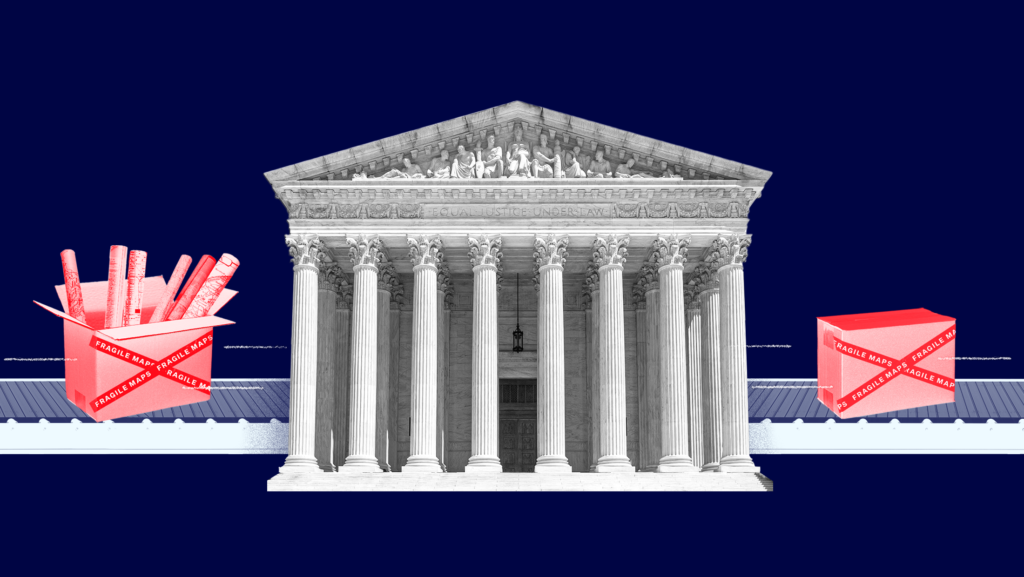Why Does the U.S. Supreme Court Get Involved in Redistricting?

In January, a panel of three federal judges blocked the use of Alabama’s new congressional map in the upcoming 2022 election. It found the map likely violates the Voting Rights Act (VRA) by diluting the votes of Black Alabamians and ordered the state to draw a new map with a second majority-Black district. But on Feb. 7, the U.S. Supreme Court stepped in, pausing the district court ruling while the appeal is litigated. The Court will hear arguments on the merits of the cases at some point in the future.
While the litigation over Alabama’s congressional map is the first time the Supreme Court has gotten involved in redistricting this cycle, it likely won’t be the last. In today’s piece, we’re breaking down why the Court got involved in Alabama and what to expect during the rest of the redistricting cycle.
When a plaintiff challenges the constitutionality of redistricting, the Supreme Court has to hear any appeal of the district court decision.
As we laid out last week in “The U.S. Court System Explained,” the Supreme Court usually gets to choose which cases it hears — a tiny fraction of all the lawsuits appealed to it. But there are some exceptions where the Supreme Court is required to accept appeals, and redistricting cases often are one of these exceptions.
Under current federal law, any case that challenges the constitutionality of a congressional or state legislative apportionment plan is required to be heard by a three-judge panel rather than a single district court judge. A separate federal law then states that any decision from one of these three-judge panels is appealable directly to the Supreme Court — and the Supreme Court has to accept the appeal and rule on the merits. It doesn’t have to hold a hearing or oral arguments, but it does have to make a final decision. Combined, these two laws effectively mean that any time a plaintiff alleges a congressional or state legislative district violates the U.S. Constitution, the Court will eventually decide the outcome if a ruling is appealed.
On the other hand, redistricting cases that do not allege any constitutional violations, like cases brought solely under the VRA, don’t follow this procedure. They go up through the federal courts as ordinary cases do and the Supreme Court can decide not to hear them.
Now, you might be wondering — if the district court’s ruling was based on the VRA, how did the Alabama cases end up before a three-judge panel in the first place and why was the decision directly appealed to the Supreme Court? It’s because the consolidated cases in Alabama alleged both constitutional violations and VRA violations — having even just one constitutional claim in your lawsuit can be enough to trigger a three-judge panel. Then, even though the district court didn’t rule on the constitutional claims, its decision still goes straight to the Supreme Court because any decision of a three-judge panel is directly appealable.
What does this mean for redistricting?
The upshot of all of this is that the Supreme Court weighs in on redistricting more frequently than most other areas of federal and constitutional law. Many of the most significant redistricting cases — such as Shaw v. Reno or Rucho v. Common Cause — reached the Supreme Court through this three-judge, direct appeal procedure. As such, the cases filed in Alabama will likely be followed by more. Already, litigation is underway in Georgia and Texas that argues new districts in those states violate the U.S. Constitution by discriminating against minority voters. Any of these cases could eventually reach the Supreme Court, and the Supreme Court will have to make a decision one way or another.
Before this redistricting cycle is over, we’re likely going to have a new Supreme Court precedent on to what extent the VRA and the Constitution protect minority voters from racially-discriminatory maps. Other cases yet to be filed could raise additional issues for the justices to consider. Stay tuned for more redistricting news, and if any more cases reach the Supreme Court we’ve got you covered with all the details.